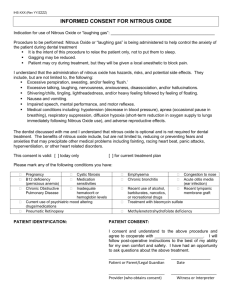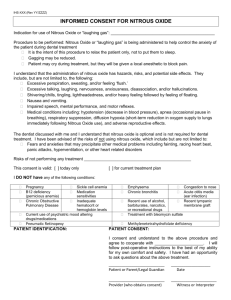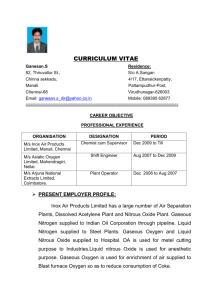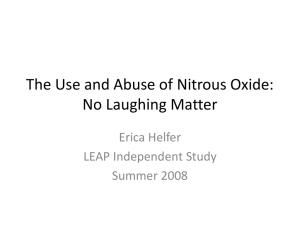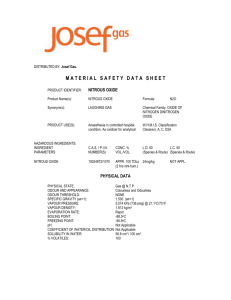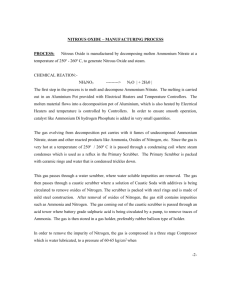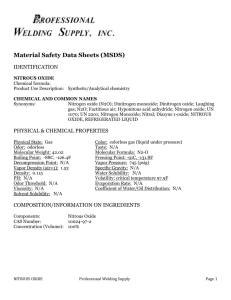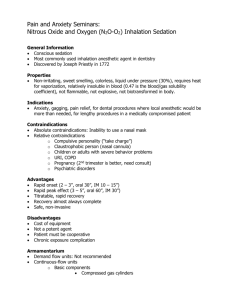Nitrous Oxide
advertisement
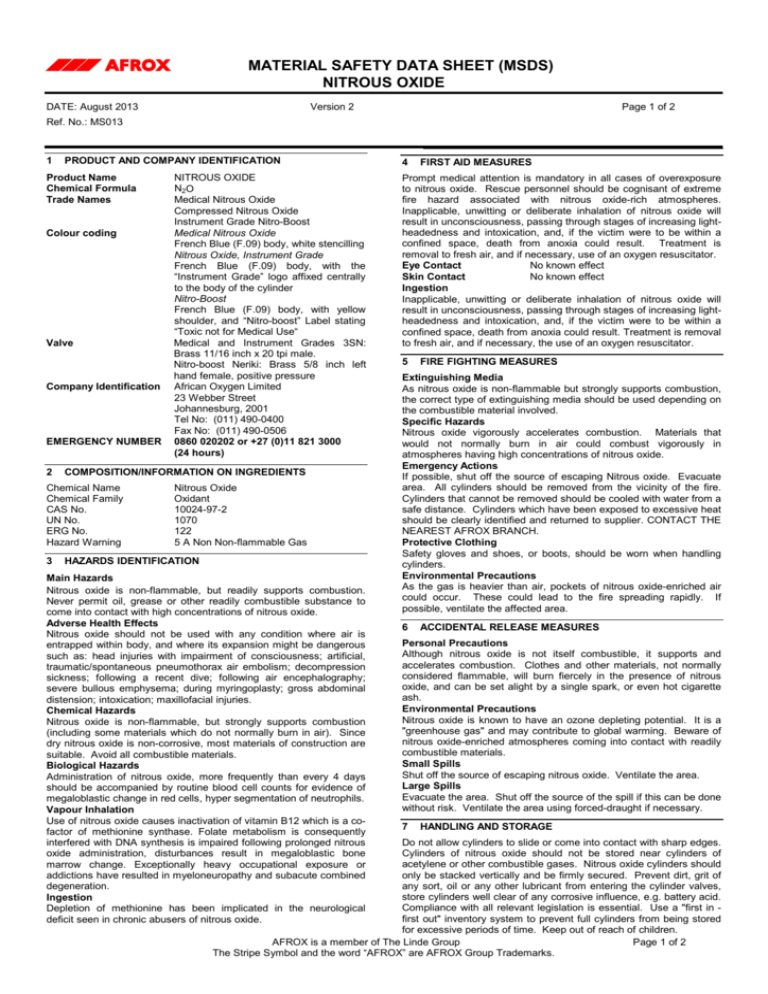
MATERIAL SAFETY DATA SHEET (MSDS) NITROUS OXIDE DATE: August 2013 Version 2 Page 1 of 2 Ref. No.: MS013 1 PRODUCT AND COMPANY IDENTIFICATION Product Name Chemical Formula Trade Names Colour coding Valve Company Identification EMERGENCY NUMBER 2 COMPOSITION/INFORMATION ON INGREDIENTS Chemical Name Chemical Family CAS No. UN No. ERG No. Hazard Warning 3 NITROUS OXIDE N2O Medical Nitrous Oxide Compressed Nitrous Oxide Instrument Grade Nitro-Boost Medical Nitrous Oxide French Blue (F.09) body, white stencilling Nitrous Oxide, Instrument Grade French Blue (F.09) body, with the “Instrument Grade” logo affixed centrally to the body of the cylinder Nitro-Boost French Blue (F.09) body, with yellow shoulder, and “Nitro-boost” Label stating “Toxic not for Medical Use“ Medical and Instrument Grades 3SN: Brass 11/16 inch x 20 tpi male. Nitro-boost Neriki: Brass 5/8 inch left hand female, positive pressure African Oxygen Limited 23 Webber Street Johannesburg, 2001 Tel No: (011) 490-0400 Fax No: (011) 490-0506 0860 020202 or +27 (0)11 821 3000 (24 hours) Nitrous Oxide Oxidant 10024-97-2 1070 122 5 A Non Non-flammable Gas HAZARDS IDENTIFICATION Main Hazards Nitrous oxide is non-flammable, but readily supports combustion. Never permit oil, grease or other readily combustible substance to come into contact with high concentrations of nitrous oxide. Adverse Health Effects Nitrous oxide should not be used with any condition where air is entrapped within body, and where its expansion might be dangerous such as: head injuries with impairment of consciousness; artificial, traumatic/spontaneous pneumothorax air embolism; decompression sickness; following a recent dive; following air encephalography; severe bullous emphysema; during myringoplasty; gross abdominal distension; intoxication; maxillofacial injuries. Chemical Hazards Nitrous oxide is non-flammable, but strongly supports combustion (including some materials which do not normally burn in air). Since dry nitrous oxide is non-corrosive, most materials of construction are suitable. Avoid all combustible materials. Biological Hazards Administration of nitrous oxide, more frequently than every 4 days should be accompanied by routine blood cell counts for evidence of megaloblastic change in red cells, hyper segmentation of neutrophils. Vapour Inhalation Use of nitrous oxide causes inactivation of vitamin B12 which is a cofactor of methionine synthase. Folate metabolism is consequently interfered with DNA synthesis is impaired following prolonged nitrous oxide administration, disturbances result in megaloblastic bone marrow change. Exceptionally heavy occupational exposure or addictions have resulted in myeloneuropathy and subacute combined degeneration. Ingestion Depletion of methionine has been implicated in the neurological deficit seen in chronic abusers of nitrous oxide. 4 FIRST AID MEASURES Prompt medical attention is mandatory in all cases of overexposure to nitrous oxide. Rescue personnel should be cognisant of extreme fire hazard associated with nitrous oxide-rich atmospheres. Inapplicable, unwitting or deliberate inhalation of nitrous oxide will result in unconsciousness, passing through stages of increasing lightheadedness and intoxication, and, if the victim were to be within a confined space, death from anoxia could result. Treatment is removal to fresh air, and if necessary, use of an oxygen resuscitator. Eye Contact No known effect Skin Contact No known effect Ingestion Inapplicable, unwitting or deliberate inhalation of nitrous oxide will result in unconsciousness, passing through stages of increasing lightheadedness and intoxication, and, if the victim were to be within a confined space, death from anoxia could result. Treatment is removal to fresh air, and if necessary, the use of an oxygen resuscitator. 5 FIRE FIGHTING MEASURES Extinguishing Media As nitrous oxide is non-flammable but strongly supports combustion, the correct type of extinguishing media should be used depending on the combustible material involved. Specific Hazards Nitrous oxide vigorously accelerates combustion. Materials that would not normally burn in air could combust vigorously in atmospheres having high concentrations of nitrous oxide. Emergency Actions If possible, shut off the source of escaping Nitrous oxide. Evacuate area. All cylinders should be removed from the vicinity of the fire. Cylinders that cannot be removed should be cooled with water from a safe distance. Cylinders which have been exposed to excessive heat should be clearly identified and returned to supplier. CONTACT THE NEAREST AFROX BRANCH. Protective Clothing Safety gloves and shoes, or boots, should be worn when handling cylinders. Environmental Precautions As the gas is heavier than air, pockets of nitrous oxide-enriched air could occur. These could lead to the fire spreading rapidly. If possible, ventilate the affected area. 6 ACCIDENTAL RELEASE MEASURES Personal Precautions Although nitrous oxide is not itself combustible, it supports and accelerates combustion. Clothes and other materials, not normally considered flammable, will burn fiercely in the presence of nitrous oxide, and can be set alight by a single spark, or even hot cigarette ash. Environmental Precautions Nitrous oxide is known to have an ozone depleting potential. It is a "greenhouse gas" and may contribute to global warming. Beware of nitrous oxide-enriched atmospheres coming into contact with readily combustible materials. Small Spills Shut off the source of escaping nitrous oxide. Ventilate the area. Large Spills Evacuate the area. Shut off the source of the spill if this can be done without risk. Ventilate the area using forced-draught if necessary. 7 HANDLING AND STORAGE Do not allow cylinders to slide or come into contact with sharp edges. Cylinders of nitrous oxide should not be stored near cylinders of acetylene or other combustible gases. Nitrous oxide cylinders should only be stacked vertically and be firmly secured. Prevent dirt, grit of any sort, oil or any other lubricant from entering the cylinder valves, store cylinders well clear of any corrosive influence, e.g. battery acid. Compliance with all relevant legislation is essential. Use a "first in first out" inventory system to prevent full cylinders from being stored for excessive periods of time. Keep out of reach of children. AFROX is a member of The Linde Group Page 1 of 2 The Stripe Symbol and the word “AFROX” are AFROX Group Trademarks. MATERIAL SAFETY DATA SHEET (MSDS) NITROUS OXIDE DATE: August 2013 Version 2 Page 2 of 2 Ref. No.: MS013 14 TRANSPORT INFORMATION 8 EXPOSURE CONTROLS/PERSONAL PROTECTION Occupational Exposure Hazards Scavenging of waste nitrous oxide gas should be used to reduce operating theatre and equivalent treatment room levels to a level below 200vpm of ambient nitrous oxide. Engineering Control Measures Engineering control measures are preferred to reduce exposure to nitrous oxide-enriched atmospheres. General methods include forced-draught ventilation, separate from other exhaust ventilation systems. Ensure that sufficient fresh air enters at, or near, floor level. Personal Protection Safety goggles, gloves and shoes should be worn when handling cylinders. Skin No known effect. 9 PHYSICAL AND CHEMICAL PROPERTIES PHYSICAL DATA Chemical Symbol Molecular Weight Specific volume @ 20°C & 101,325 kPa Boiling point @ 101,325 kPa Density, gas @ 101,325 kPa & 20°C Relative density (Air=1) @ 101,325 kPa Colour Taste Odour N2O 44.01 543.1 ml/g - 88.5°C 1.8432 kg/m3 1.5297 None Sweet Sweet ROAD TRANSPORTATION UN No ERG No Hazchem warning SEA TRANSPORTATION IMDG Class Packaging group Label AIR TRANSPORTATION ICAO/IATA Code Class Packaging group Packaging instructions - Cargo - Passenger Maximum quantity allowed - Cargo - Passenger 11 TOXICOLOGICAL INFORMATION Acute Toxicity See Section 3 Skin & eye contact No known effect Chronic Toxicity See Section 3 Carcinogenicity No known effect Mutagenicity No known effect Reproductive Hazards See Section 3 (For further information see Section 3. Adverse Health effects) 12 ECOLOGICAL INFORMATION Nitrous oxide is heavier than air and care should be taken to avoid the formation of nitrous oxide-enriched pockets. It does not pose a hazard to the ecology. 13 DISPOSAL CONSIDERATIONS Disposal Methods Small amounts may be blown to atmosphere under controlled conditions. Large amounts should only be handled by gas supplier. Disposal of Packaging The disposal of containers must only be handled by the gas supplier. 1070 Non-flammable Gas 1070 2.2 200 200 150kg 75kg 15 REGULATORY INFORMATION EEC Hazard class Risk Phrase R8 10 STABILITY AND REACTIVITY Conditions to avoid Build up of nitrous oxide-enriched atmospheres. Never use cylinders as rollers or supports, or for any other purpose than the storage of Nitrous oxide. Never expose cylinders to excessive heat, as this may cause sufficient build-up of pressure to rupture the cylinders. Incompatible Materials Since dry nitrous oxide is non-corrosive, most materials of construction are suitable. Avoid all flammable materials. Hazardous Decomposition Products When involved in a fire the higher oxides of nitrogen can be formed. Both nitric oxide and nitrogen dioxide are highly toxic. 1070 122 5 A Non-flammable Gas R20 R33 R44 R48 Description Contact with combustible material may cause fire Harmful by inhalation Danger of cumulative effects Risk of explosion if heated under confinement Danger of serious damage to health by prolonged exposure Non-flammable Safety Phrase S2 Description Keep out of reach of Children S3 Keep in a cool place S9 Keep container in a wellVentilated place S21 When using do not smoke S44 If you feel unwell, medical advice seek National legislation: None Refer to SANS 10265 for explanation of the above. 16 OTHER INFORMATION Bibliography SANS 10265 - Labelling of Dangerous Substances 17 EXCLUSION OF LIABILITY Information contained in this publication is accurate at the date of publication. The company does not accept liability arising from the use of this information, or the use, application, adaptation or process of any products described herein. AFROX is a member of The Linde Group The Stripe Symbol and the word “AFROX” are AFROX Group Trademarks. Page 2 of 2
